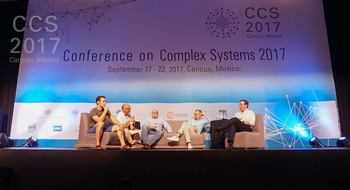
Conference on Complex Systems 2017
Sep 17 - 22. Cancun, Mexico

Mobility of the future
How to predict urban mobility from complexity science?
Published on September 21, 2017 18:57
Written by Israel Colchado / Translation by Carlos López Natarén
We are many and we will be more. According to a United Nations study, by 2014, 54% of the world's population lived in cities and by 2050 the world's urban population will exceed 66%.
A key issue for the future is to analyze (and ideally predict) how all these people will move. During her plenary lecture at the Conference on Science Complex 2017, urban mobility specialist Marta C. González showed some results to solve this problem using an approach from the complexity sciences.
"When you study the data of a complex system, what kind of scientist you are? Someone trying to find universal standards and laws (universality) or someone looking for differences and variations (heterogeneity)?", Gonzalez asked to the audience.
She mentioned that although they appear very contradictory positions, both can be seen as one. In fact, for scientists both approaches are necessary in their model of human mobility.
"We need the combination of both positions, universality and heterogeneity, to convert fingerprint signals into a model capable of creating synthetic trajectories similar to what people would do in cities. It would be a very useful model in terms of planning," said the researcher.
Starting from the universal approach, the researcher uses an approach called "gravity law". From this perspective, you can analyze the user who decides his trips from the distance and the infrastructure at his disposal.
From the heterogeneity approach, on the other hand, it allows analyzing how the user modifies his behavior when transportation resources are limited. People can decide with some probability how to make their trip; they can be selfish (they adapt the environment to their advantage); they can follow a habit (they always walk the same way) or they can be altruistic, that is to say, they prefer that other users use these resources at their own expense.
Thus, for Marta González, the universal and heterogeneous approaches will work together to better understand how the user moves and how these mobility patterns will be transformed in the future, when the population increase and limitations in transportation are more evident.
Latest News

Sobre cómo se forma la opinión pública
Jorge Louca presentó su estudio sobre cómo es la dinámica de la opinión pública con la influencia de los medios de comunicación.

El padre de la ciencia de redes en México
Medir, predecir y controlar los sistemas complejos, dijo el rumano Albert-László Barabási en la CCS17.

¡Cierra el CCS17 en México!
Con más de 500 asistentes concluye la treceava edición del evento académico más importante del mundo en sistemas complejos.


